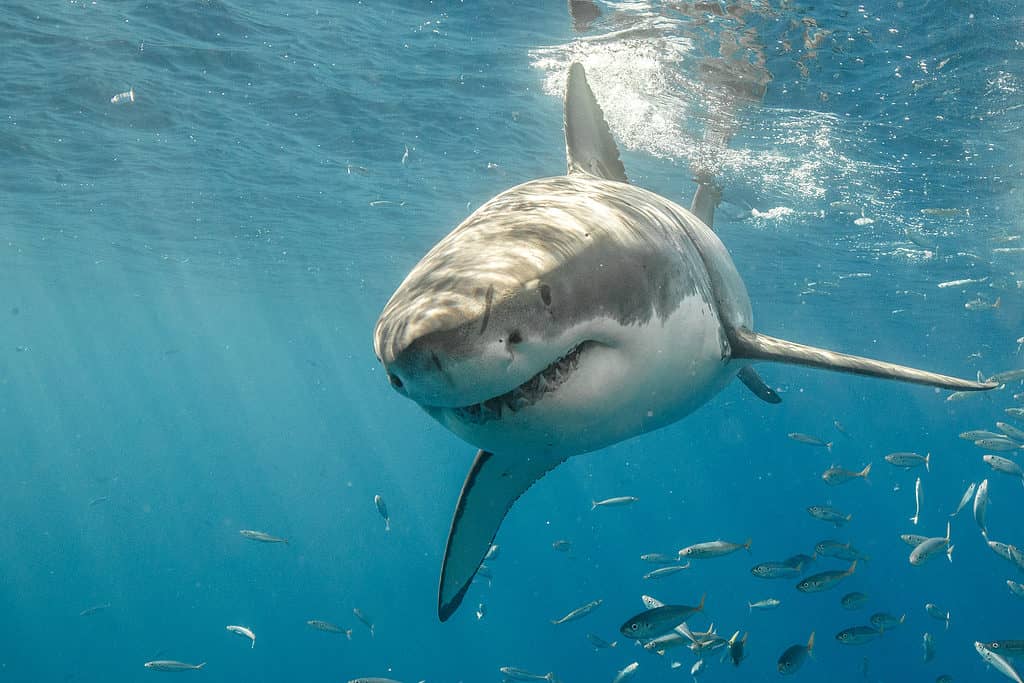Incredible apex predators of the seas, great white sharks are a critical part of the ocean ecology. After their numbers plummeted by about 70% since the 1970s, researchers and conservationists set out to understand the lives of these animals to save them from a human-caused extinction event. In the mid-1990s, following intensive studying of white shark behavior, researchers discovered that these amazing fish are partially endothermic.
So, why are great white sharks warm-blooded when the vast majority of other sharks aren’t? Read on to find out.
Great White Sharks: An Overview
The great white shark, referred to by scientists as the white shark (Carcharodon carcharias), inhabits temperate and subtropical waters around the world. This species of highly migratory shark can grow up to, and occasionally over, 20 feet long. The largest females can tip the scales at over 4,000 pounds. When unencumbered by disease, destructive human activity, or their very few predators, white sharks can live up to, or even over, 70 years.
Migration and Reproduction
These incredible animals can migrate over 2,500 miles annually. White sharks primarily travel to follow ideal water temperatures, reproduce, and hunt. Great whites have ovoviviparous reproduction. This means they grow and nourish embryos internally before giving birth to live young. Shark biologists believe white shark gestation lasts about 12 months. They can give birth to 2-12 pups at a time, and the young are born measuring 4-5 feet in length.
Diet
Juvenile white sharks feed primarily on schooling fish, squids, smaller sharks and rays, and bottom-dwelling fish. As subadults and adults, they shift to a diet primarily consisting of marine mammals, such as seals, porpoises, ocean otters, and sea lions.

Great white sharks are an apex oceanic predator, capable of measuring over 20 feet in length.
©iStock.com/ShaneMyersPhoto
Are Great White Sharks Warm-Blooded: And Why?
In contrast to about 99% of all shark species, great white sharks are warm-blooded to an extent. In scientific terms, this means these sharks are partial endotherms. Most shark species, are ectothermic, meaning their body temperature matches the temperature of the water in which they swim. As an endotherm, however, great white sharks can maintain body temperatures above that of their surrounding environment.
Specifically, the great white shark can keep critical parts of its body up to about 40 degrees Fahrenheit warmer than the temperature of cold waters. A specialized network of tiny blood vessels called the rete mirabile, is mostly responsible for the shark’s endothermic abilities. This structure can retain the heat produced by the shark’s powerful red muscles and circulate it to critical parts of the body, primarily the stomach, eyes, and brain. The muscles are also able to retain heat. Scientists call this process, which circulates warm blood from the red muscles to critical organs, the countercurrent heat exchange. Additionally, thermal conduction via vessels inside the liver is also responsible for the increased temperature of the shark’s stomach.
Why Are Great White Sharks Warm-Blooded?
Technically, great white sharks are partially warm-blooded since the rete mirabile only circulates heat to certain parts of the body and in certain environments.
But, why does this happen in the first place? What purpose does this serve the great white? The endothermic properties of great whites allow them several advantages. With increased body temperatures they can achieve such powerful, fast energy bursts during hunting, especially in colder waters. An increased body temperature also correlates to their increased metabolism compared to ectothermic sharks. This increased metabolic rate and warmer stomach allows for quicker food digestion. Finally, warmer eyes and brains can process information faster. This faster processing ability provides a hunting advantage for the great white, especially with quick, dynamically moving prey.

The endothermic abilities of white sharks allow them to breach in powerful, fast bursts while hunting.
©Sergey Uryadnikov/Shutterstock.com
Are Great White Sharks Warm-Blooded: the Lamnidae Family
Great white sharks are part of the Lamnidae, or mackerel, family of sharks. Great white sharks are not unique in their ability to partially regulate their internal body temperature. All five species of sharks in the Lamnidae family are capable of partial endothermic abilities. The other four species of this family are the shortfin mako (Isurus oxyrinchus), longfin mako (Isurus paucus), salmon shark (Lamna ditropis), and the porbeagle shark (Lamna nasus). Unsurprisingly, this partially endothermic family contains the fastest shark species in the world.

The great white shark is part of the
Lamnidae, or mackerel, family. All five species in this family are partially endothermic.
©USO/Shutterstock.com
The photo featured at the top of this post is © iStock.com/Whitepointer
Thank you for reading! Have some feedback for us? Contact the AZ Animals editorial team.







